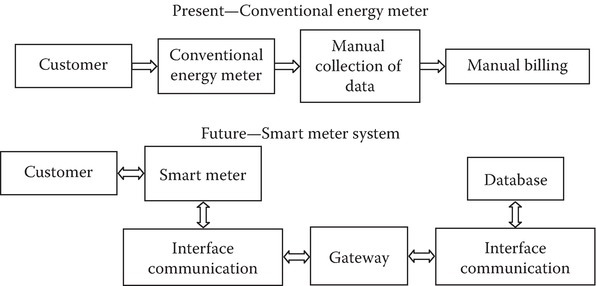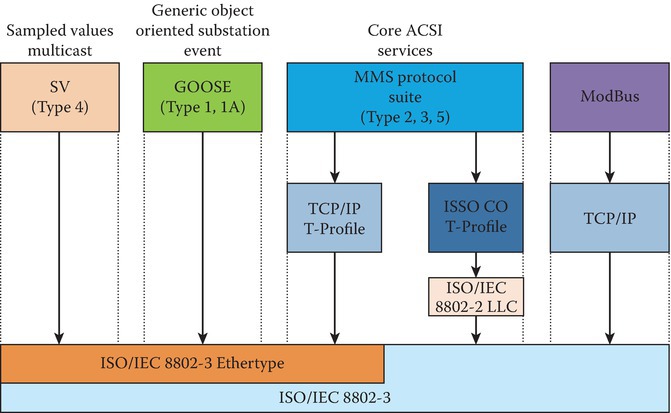Smart Grid is characterized by a series of integrated technologies, methodologies, and procedures for planning and operation of electrical systems, being favored by the increase of resources related to information, communication, and engineering technologies.
Another feature is the diversity of application areas, e.g., energy technologies, transportation efficiencies, utility transformations, and building innovations. In this context, electronic instrumentation is a key part, since the active management of power systems is performed by complex monitoring and control instrumentation and networks.
The electrical systems can be considered one of the largest and most complex dynamic systems built by humanity. These systems are responsible for the interaction of generation, transmission, and distribution of electrical power to comply with reliability and quality standards with minimal cost and environmental impact.
This complex interconnection of information, communication, and engineering technologies, as demanded by smart grids, can be supplied by the several instrumentation techniques. In particular, this article presents an overview of the technologies and applications for Smart Grid.
Smart Grid IEEE Definition
The concept of Smart Grid is quite comprehensive, but there is no unique definition. The IEEE P2030 Project has some conceptual ideas and formulations. One of them defines a Smart Grid as follows:
“In a generic and holistic definition, the Smart Electric Grid or Smart Power (Smart Grid) is a complex end to end system that is composed of multiple sub-power systems interconnected and interrelated to each other through multiple protocols that contain multiple layers of technologies (energy, ICT and control/automation).”
- You May Also Read: Smart Grid Technology and Applications
It means that the electrical network uses advanced technology to monitor and manage in real time the transportation of energy, through the power flow and a two-way information between the power supply and the end customer, integrating and enabling actions by all users connected to this system, providing a sustainable, economical, and safe energy efficiently.
Besides that, this system provides customers with information about their consumption, rates, taxes, and product and service quality in real time.
The introduction of Smart Grids will produce a marked convergence among the infrastructure of generation, transmission, and distribution of energy, digital communications, and data processing. The latter will work as an Internet Equipment connecting the so-called IEDs (Intelligent Electronic Devices) and exchanging information and control actions among different segments of the grid.
This convergence of technologies will require the development of new control, automation, and optimization methods for the electrical system, with a strong trend to use techniques for a distributed problem-solution based on multi-agents.
Smart Grid Characteristics
Some of the common characteristics assigned to Smart Grids are as follows:
- Self-healing: Online evaluation and pre-control of system failures, automatic fault, and restoring
- Interactivity: The ability to execute interactions between the distribution network and the consumer to get the power flow information and two-way interaction flow of capital
- Robust: Better response time in cases of natural human disasters, protection, and information security
- Optimization: Improvement of the asset utilization, reduction of operating and maintenance costs, and reduction of losses
- Compatibility: Large generators, alternative energy sources, distributed generation, etc.
- Integration: Improvement of processes, integration of information, and standardization/management refinements
Since the concept of Smart Grid is quite broad, their development goals also change according to the strategy and grid codes of each country.
Smart Grid Benefits
Regarding the interests of the power utility, in general, the following benefits are associated with Smart Grid, consumers, and regulating agents:
- Improvement of the service quality provided by the utilities
- Reduction of CO2emission
- Promotion of energy efficiency
- Integration of renewable sources and grid, increasing the participation of the distributed generation
- Preparation for the advent of the electric vehicle
- Increase the system reliability
- Ability of self-healing
- Online monitoring and control
- Smart meters with two-way communication
- Reduction of the operating costs
- Improvement of the network expansion planning
- The increase of the asset management
- Promotion of the technology industry
A Smart Grid consists primarily of four components, all of them permeated by ITC:
Home Area Network(HAM):
Home networks include smart appliances, self-generation, electric vehicles, and smart meters that work as gateways that interact with the user and are related to the proposal of moderate consumption and efficient use of energy.
They are critical infrastructures for the development of Smart Grids. Their main function is enabling the consumer and the system to establish contact with the load as well as the consumer participation in the system, who can even provide energy to the grid.
The smart energy meter acts as a sensor and establishes the information exchange between network and load, allowing functions such as the deployment of hourly rates, monitoring power quality, remote switching (disconnection/connection), and prepayment.
Advanced Distribution Operation(ADO):
Full automation of all control devices and operating functions of the distribution network with the aim of smart grid self-correction and efficiency. As examples, there are the automatic controls of switches, voltage, and reactive flow.
Advanced Transmission Operation(ATO):
Focus on the management of energy exchanges and reduction of blackout risks, providing improved information exchange among subsystems, and quick response to disasters and dynamic disturbances. Examples include the integration of synchronized phasor measurements, high-temperature superconductor cables, flexible AC transmission (FACTS), advanced protection relays, and high-voltage DC transmission (HVDC).
Advanced Asset Management(AAM):
A tool for asset system management, which is divided into four layers: consumer, logic, application services, and system services. AAM is responsible for the equipment control, ECS failure detection, maintenance, and spare part stocks, among others.
Distribution System Automation
A high degree of automation is expected in a Smart Grid. The network infrastructure must support data management of electronic meters (MDMs), monitoring and control of network status (overload, reactive power control, etc.), load and distributed generation management, and charging of plug-in hybrid electric vehicles (PHEVs), among other features.
Information systems should communicate with each other at different implementation levels, such as power regulation strategies, billing, maintenance management, consumer and network databases, and geographic information systems (GIS).
Interoperability between standards and communication protocols plays a critical role in the advancement of Smart Grids.
At the operation center, the supervisory system (SCADA) performs the interface between the technical team (operator, planner, supervisor, etc.) and the network devices.
At the distribution network, some automation features may include automatic adjustment of protection devices, automatic regulation of voltage levels, control of capacitor banks and transformer’s taps, control of distributed generation, and self-reconfiguration, in addition to the automatic management of loads and consumption measurements.
Furthermore, the automation requires remote-controlled equipment (switches, reclosers, circuit breakers, etc.), digital controllers, and Intelligent Electronic Devices (IEDs).
Advanced Metering Infrastructure
The modernization of power distribution networks has taken place in several countries since the 1980s, especially with the replacement of electromechanical meters by the electronic ones.
In order to replace them, it is a necessary, but not sufficient, condition for smart metering. Smart metering is often regarded as the smart grid itself, but it is only the beginning to achieve the overall concept (see Figure 1).
FIGURE 1 Current and future metering methodology.
The following perceptions can be focused:
AMR (Automated Meter Reading), which is a concept related to a one-way communication with the Measurement Control Center (MCC) for the process of power generation bill, aiming greater accuracy in measurements and cost-saving costs to users.
A smart meter is an electronic meter (or digital), whose capacity is far beyond the measurement of energy consumption for electrical power applications. This equipment is capable of recording data at configurable time intervals, and it allows bidirectional communications with the MCC. To reach the overall concept of the Smart Grid, the smart meter must also allow the integration of smart appliances.
AMM (Advanced Meter Management) is related to a technical management platform of smart meters arranged in communication networks, being capable of reading load profiles in time intervals of less than one hour. This can be thought of as any management action of the meter as grid asset.
Its basic functions are (i) device parameter management, (ii) group management to allow control of groups of devices, as configuration and firmware upgrade, and (iii) communication platform management, ensuring reliable communication between meters and MCC and reporting network status, communication performance, and special situations. It is important to notice that the AMM does not save the data collected by the meters (even temporarily)— it just transmits them to MDM.
MDM (Meter Data Management) processes and manages data generated by the meters, including information beyond just energy consumption, such as power factor and quality indexes. It aims to improve processes such as billing, operational efficiency, customer services, forecasting of power demand, Distribution Management System (DMS), fraud management, demand management, and others.
The issue is not just on how to collect remote data (AMM function) but also on how to manage them for further information. Its basic functions are (i) working as a data repository of records, events, and alarms and (ii) processing and analyzing data from the meters, wherever the validation and correction of inconsistent data are applied and transforming elementary load profiles into useful information to the utility.
AMI (Advanced Metering Infrastructure): Some authors use the term AMI as a synonym for smart metering, covering the concepts of AMM and MDM. In practical terms, it is related to the means of communication infrastructure that are required to allow the functionalities of smart metering.
The automation of equipment and how to decide when to consume energy regarding the set of customer preferences can reduce the peak load, which has a large impact on the power generation costs and postpone the need for construction of new power plants.
Advanced Metering Infrastructure (AMI) involves all elements necessary for communication between consumers and utilities or suppliers. The communication is bidirectional and allows the dealer to inform the consumer, e.g., the real-time value of the energy. One of its structure is the Smart Meter, which allows real-time measurement and reception of power utility commands.
Smart meters can communicate and execute commands by the remote or local control as the most advanced way to monitor and control electronic devices installed at the client site.
It is responsible for collecting system diagnostic information plus communicating with other smart meters. It can still limit the maximum power consumption and remotely disconnect or reconnect the power supply. It warns outages of energy and alerts frauds.
Smart Grid Standards
Standards such as those present in IEC 61850 specify issues relating to the automation of the system control of power substations.
There are also other standards that take directly into consideration the security issues involved in these applications, such as the IEC 62351 family of standards. However, each SCADA system provides these standards by implementing security in a specific way.
Standard 61850
IEC 61850 is standard regulating communication within a power substation environment. It is a standard that has gained global acceptance by both suppliers and customers, which, in this case, is represented by power utilities. This standard sets strict rules for interoperability between independent manufacturer devices, thus providing protection, monitoring, control, and automation.
Figure 2 shows the main communication services defined by standard IEC 61850 and also the MODBUS protocol. These services are provided in application layers where different communication modes are used, such as MMS, GOOSE, and TCP/IP.
FIGURE 2 Adapted from IEC 61850 communication and services.
The standard IEC 61850 consists of 10 parts, each one dealing with a specific topic, which broadly addresses the topic proposed for substation automation systems.
The IEC 61850 series provides not only data transfer, but it is a complete structure that separates the application and communication systems through the use of an abstract interface.
Standard 62351
The standard IEC 62351 establishes the information security standards for control operations in a power system.
The standard IEC 62351 is currently divided into 11 parts, each one dealing with a specific topic. IEC 62351 provides different methods to ensure different communication types in the standard IEC 61850.



